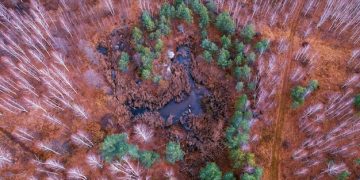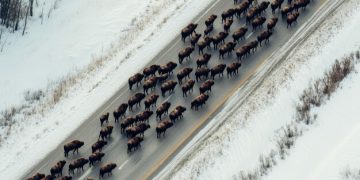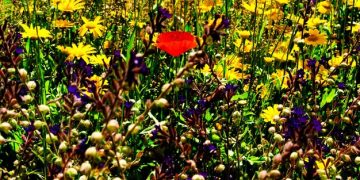Prescribed Burns: How Controlled Fires Benefit US Wildlife Habitats

Prescribed burns, or controlled fires, play a vital role in maintaining and enhancing wildlife habitats in the US by reducing wildfire risks, promoting biodiversity, and improving ecosystem health.
Understanding ecological processes is crucial for effective wildlife habitat management. One such process, often misunderstood, is the role of fire. In the United States, understanding the role of prescribed burns: how controlled fires benefit wildlife habitats in the US, is critical for maintaining biodiversity and ecosystem health.
What are prescribed burns?
Prescribed burns, also known as controlled burns, are intentionally set and managed fires used for specific land management purposes. These fires are carefully planned and executed by trained professionals to achieve objectives such as reducing wildfire hazards, improving wildlife habitat, and restoring ecosystem health.
Unlike wildfires, which are often destructive and unpredictable, prescribed burns are conducted under specific weather conditions and with predetermined boundaries to ensure they remain under control. Proper planning and execution are essential for the success and safety of these burns.
Why are prescribed burns necessary?
Prescribed burns are necessary because many ecosystems in the United States evolved with fire as a natural process. Fire helps to maintain the balance and health of these ecosystems by promoting regeneration, reducing fuel buildup, and controlling invasive species. Without fire, these ecosystems can become degraded and more vulnerable to catastrophic wildfires.
In many areas, fire suppression policies have led to an accumulation of dead vegetation and other fuels, increasing the risk of severe wildfires. Prescribed burns help to mitigate this risk by reducing the amount of available fuel and creating fire breaks. They also play a crucial role in maintaining biodiversity and supporting wildlife habitats.
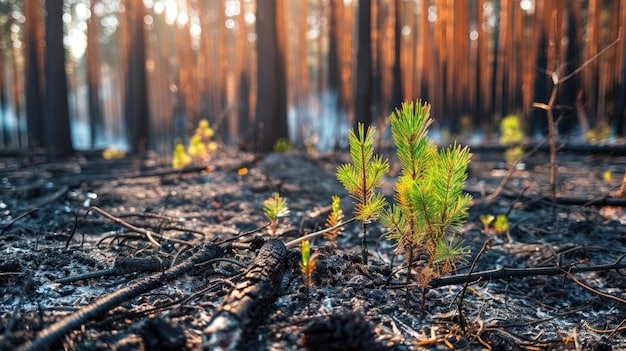
To summarize, prescribed burns offer a proactive approach to land management that restores ecological harmony while minimizing the potential for destructive wildfires.
Benefits of prescribed burns for wildlife habitats
Prescribed burns offer a wide range of benefits for wildlife habitats. From promoting new plant growth to creating diverse habitats, these controlled fires play a crucial role in supporting a variety of species. Understanding these benefits can help to highlight the importance of prescribed burns in conservation efforts.
These burns are not just destructive forces; they’re tools that, when used correctly, foster biodiversity and enhance the resilience of ecosystems.
Promoting new plant growth
One of the primary benefits of prescribed burns is their ability to promote new plant growth. Fire removes dead vegetation and opens up the canopy, allowing sunlight to reach the forest floor. This sunlight encourages the germination of seeds and the growth of new plants, providing food and habitat for wildlife.
Many plant species are adapted to fire and even depend on it for their survival. For example, some plants have seeds that only germinate after exposure to fire, while others have root systems that are resistant to fire damage. These plants can quickly regenerate after a burn, providing a valuable food source for wildlife.
Creating diverse habitats
Prescribed burns help to create diverse habitats by creating a mosaic of burned and unburned areas. This mosaic provides a variety of different habitat types, supporting a wider range of wildlife species. Burned areas can provide open areas for foraging, while unburned areas provide cover and nesting sites.
By varying the intensity and frequency of burns, land managers can create a patchwork of different habitat types, each with its unique characteristics. This diversity is essential for supporting a healthy and resilient wildlife population. The creation of diverse habitats ensures that different species can find the specific resources they need to thrive.
- Reduce wildfire hazards by removing dead vegetation
- Promote regeneration and new plant growth
- Control invasive species
- Create diverse habitats and mosaics of varied ecosystems
In conclusion, the multifaceted benefits of prescribed burns contribute significantly to the health and resilience of wildlife habitats.
How prescribed burns reduce wildfire risks
One of the most significant benefits of prescribed burns is their ability to reduce wildfire risks. By removing dead vegetation and other fuels, these fires can help to prevent the buildup of hazardous fuel loads. This reduces the likelihood of large, uncontrolled wildfires and protects communities and ecosystems.
The strategic use of prescribed burns can create firebreaks, which act as barriers to prevent the spread of wildfires. These firebreaks can be particularly effective in protecting valuable resources such as homes, forests, and watersheds.
Controlling the spread of invasive species
Invasive species can pose a serious threat to wildlife habitats by outcompeting native plants and disrupting ecosystem processes. Prescribed burns can help to control the spread of invasive species by killing or suppressing their growth. Some invasive species are particularly vulnerable to fire, while native plants are often adapted to withstand fire.
By targeting invasive species with prescribed burns, land managers can help to restore native plant communities and improve habitat quality for wildlife. This is particularly important in areas where invasive species have become dominant and are threatening the survival of native species.
Protecting communities and ecosystems
Prescribed burns not only benefit wildlife habitats but also protect communities and ecosystems from the destructive effects of wildfires. Large, uncontrolled wildfires can cause significant damage to property, infrastructure, and natural resources. They can also release large amounts of smoke and pollutants into the atmosphere, affecting air quality and human health.
By reducing the risk of wildfires, prescribed burns help to protect these valuable assets and ensure the long-term health and resilience of communities and ecosystems. They provide a cost-effective and environmentally sound alternative to more intensive fire suppression methods.
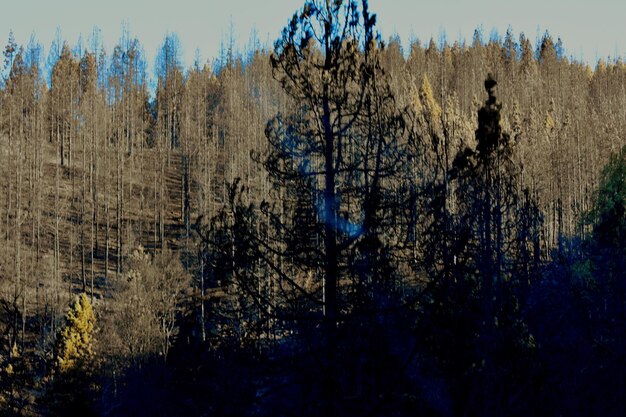
All in all, the strategic implementation of prescribed burns is instrumental in safeguarding both ecological health and community well-being by significantly diminishing the potential for devastating wildfires.
The science behind prescribed burns
The practice of prescribed burning relies on a solid foundation of scientific understanding. Fire ecologists study the effects of fire on ecosystems and use this knowledge to develop effective burning prescriptions. These prescriptions take into account factors such as weather conditions, fuel loads, and desired outcomes.
Understanding the science behind prescribed burns is essential for ensuring that these fires are conducted safely and effectively. It also helps to inform public understanding and support for this important land management practice.
Understanding fire ecology
Fire ecology is the scientific discipline that studies the effects of fire on ecosystems. Fire ecologists investigate how fire influences plant and animal communities, nutrient cycling, and other ecological processes. This knowledge is used to develop burning prescriptions that mimic natural fire regimes and achieve specific management objectives.
Fire ecologists also study the role of fire in different ecosystems, from grasslands to forests. They examine how different fire frequencies and intensities affect ecosystem health and biodiversity. This information is crucial for understanding the long-term effects of prescribed burns.
Developing burning prescriptions
Burning prescriptions are detailed plans that outline the specific conditions under which a prescribed burn will be conducted. These prescriptions take into account factors such as weather conditions, fuel loads, and desired outcomes. They also specify the equipment and personnel required to safely conduct the burn.
Developing a burning prescription involves a careful assessment of the site and its surrounding environment. Land managers must consider the potential impacts of the fire on air quality, water resources, and wildlife. They must also obtain the necessary permits and approvals before conducting the burn.
- Weather conditions that influence fire behavior and safety
- Fuel loads to ensure effective and controlled burning
- Desired ecological and management outcomes
- Potential impacts on air quality, water, and wildlife
In summary, the scientific rigor behind prescribed burns ensures they are a safe, effective, and environmentally sound approach to land management.
Challenges and considerations
Despite the many benefits of prescribed burns, there are also challenges and considerations that must be taken into account. These include public perception, air quality concerns, and the risk of escape. Addressing these challenges requires careful planning, communication, and collaboration.
Land managers must work closely with communities and stakeholders to ensure that prescribed burns are conducted safely and responsibly. This involves providing clear and accurate information about the purpose and benefits of these fires, as well as addressing any concerns or questions.
Addressing public perception
Public perception can be a significant barrier to the implementation of prescribed burns. Many people associate fire with destruction and danger, and may be hesitant to support the use of controlled burns. Addressing this perception requires effective communication and education.
Land managers can help to improve public perception by providing clear and accurate information about the purpose and benefits of prescribed burns. They can also involve the public in the planning and execution of these fires, allowing them to see firsthand how they are conducted safely and responsibly.
Managing air quality
Prescribed burns can release smoke and pollutants into the atmosphere, affecting air quality and human health. Managing air quality is a critical consideration in the planning and execution of these fires. Land managers must carefully monitor weather conditions and use techniques to minimize smoke production.
They can also work with air quality regulators to obtain permits and ensure that prescribed burns are conducted in compliance with air quality standards. This may involve adjusting the timing or location of burns to minimize impacts on sensitive areas.
- Address negative public perception through education and transparency
- Manage air quality through precise monitoring and techniques
- Mitigate potential risks of burns escaping
- Comply with environmental regulations and safety standards
In conclusion, overcoming these challenges is essential for the continued and responsible use of prescribed burns in land management.
The future of prescribed burns
As climate change continues to alter ecosystems and increase the risk of wildfires, the role of prescribed burns is likely to become even more important. Prescribed burns can help to mitigate the effects of climate change by reducing fuel loads, restoring ecosystem health, and promoting biodiversity. They also offer a cost-effective and environmentally sound alternative to more intensive fire suppression methods.
Investing in research and training is essential for ensuring that prescribed burns are conducted safely and effectively in the future. This includes developing new techniques for predicting fire behavior, monitoring air quality, and engaging with communities and stakeholders.
Investing in research and training
Research and training are essential for advancing the science and practice of prescribed burning. Researchers can help to develop new techniques for predicting fire behavior, monitoring air quality, and assessing the ecological effects of fire. Training programs can equip land managers with the skills and knowledge they need to safely and effectively conduct prescribed burns.
Investing in research and training can help to ensure that prescribed burns are conducted in a way that maximizes their benefits for wildlife habitats and minimizes their potential risks.
Collaborating with stakeholders
Collaboration with stakeholders is essential for building support for prescribed burns and ensuring that they are conducted in a way that meets the needs of communities and ecosystems. Stakeholders include landowners, community members, environmental groups, and government agencies. By working together, these groups can help to develop and implement effective burning programs.
Collaboration can also help to address concerns about air quality, safety, and other potential impacts of prescribed burns. By involving stakeholders in the decision-making process, land managers can build trust and ensure that prescribed burns are conducted in a responsible and transparent manner.
In summary, the future of prescribed burns hinges on continuous research, training, and collaborative efforts to adapt to changing environmental conditions and societal needs.
| Key Aspect | Brief Description |
|---|---|
| 🔥 Fuel Reduction | Controlled fires decrease wildfire risk by clearing excess vegetation. |
| 🌱 Habitat Renewal | Fire promotes new plant growth, enriching food for wildlife. |
| 🌿 Biodiversity | Creating diverse habitats supports a wide range of species. |
| 🛡️ Ecosystem Health | Fire controls invasive species and helps maintain ecosystem balance. |
Frequently Asked Questions
▼
A prescribed burn is a controlled fire intentionally set by trained professionals to manage vegetation, reduce wildfire risk, and improve ecosystem health in a specific area.
▼
They reduce wildfire risks by eliminating fuel buildup, promote new plant life for improved wildlife grazing, and control spreading invasive plant types.
▼
Trained staff, appropriate moisture levels, moderate environmental humidity, light presence of wind, and proper notifications and permits are needed.
▼
These controlled events promote open-ground forage for native wildlife. They foster a variety of plant life and species diversity after suppression of invasives.
▼
Factors such as inadequate plan details, unseasonably high winds, severe drought conditions. Plus, failure to gain community buy-in can result in operational concerns.
Conclusion
In conclusion, understanding the role of prescribed burns: how controlled fires benefit wildlife habitats in the US is essential and is necessary for maintaining ecosystem health, reducing wildfire risks, and promoting biodiversity. While there are challenges and considerations that must be taken into account, the benefits of these fires far outweigh the risks. By investing in research, training, and collaboration, we can ensure that prescribed burns continue to play a vital role in managing our landscapes and protecting our communities.

